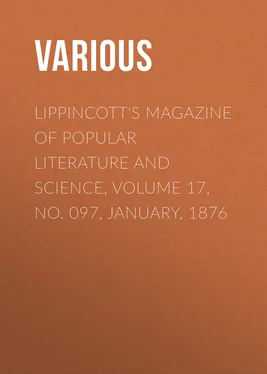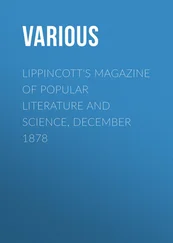Various - Lippincott's Magazine of Popular Literature and Science, Volume 17, No. 097, January, 1876
Здесь есть возможность читать онлайн «Various - Lippincott's Magazine of Popular Literature and Science, Volume 17, No. 097, January, 1876» — ознакомительный отрывок электронной книги совершенно бесплатно, а после прочтения отрывка купить полную версию. В некоторых случаях можно слушать аудио, скачать через торрент в формате fb2 и присутствует краткое содержание. Издательство: Иностранный паблик, Жанр: foreign_antique, periodic, foreign_edu, на английском языке. Описание произведения, (предисловие) а так же отзывы посетителей доступны на портале библиотеки ЛибКат.
- Название:Lippincott's Magazine of Popular Literature and Science, Volume 17, No. 097, January, 1876
- Автор:
- Издательство:Иностранный паблик
- Жанр:
- Год:неизвестен
- ISBN:нет данных
- Рейтинг книги:3 / 5. Голосов: 1
-
Избранное:Добавить в избранное
- Отзывы:
-
Ваша оценка:
- 60
- 1
- 2
- 3
- 4
- 5
Lippincott's Magazine of Popular Literature and Science, Volume 17, No. 097, January, 1876: краткое содержание, описание и аннотация
Предлагаем к чтению аннотацию, описание, краткое содержание или предисловие (зависит от того, что написал сам автор книги «Lippincott's Magazine of Popular Literature and Science, Volume 17, No. 097, January, 1876»). Если вы не нашли необходимую информацию о книге — напишите в комментариях, мы постараемся отыскать её.
Lippincott's Magazine of Popular Literature and Science, Volume 17, No. 097, January, 1876 — читать онлайн ознакомительный отрывок
Ниже представлен текст книги, разбитый по страницам. Система сохранения места последней прочитанной страницы, позволяет с удобством читать онлайн бесплатно книгу «Lippincott's Magazine of Popular Literature and Science, Volume 17, No. 097, January, 1876», без необходимости каждый раз заново искать на чём Вы остановились. Поставьте закладку, и сможете в любой момент перейти на страницу, на которой закончили чтение.
Интервал:
Закладка:
A few who have not heard of them have heard of Wolsey. The pursy old cardinal furnishes the surviving one of the two main props of Hampton's glory. An oddly-assorted pair, indeed—the delicate Italian painter, without a thought outside of his art, and the bluff English placeman, avid of nothing but honors and wealth. And the association of either of them with the spot is comparatively so slight. Wolsey held the ground for a few years, only by lease, built a mere fraction of the present edifice, and disappeared from the scene within half a generation. What it boasts, or boasted, of the other belongs to the least noted of his works—half a dozen sketches meant for stuff-patterns, and never intended to be preserved as pictures. Pictures they are, nevertheless, and all the more valuable and surprising as manifesting such easy command of hand and faculty, such a matter-of-course employment of the utmost resources of art on a production designed to have no continuing existence except as finished, rendered and given to the world by a "base mechanical," with no sense of art at all.
Royalty, and the great generally, availed themselves of their opportunities to select the finest locations and stake out the best claims along these shores. Of elevation there is small choice, a level surface prevailing. What there is has been generally availed of for park or palace, with manifest advantage to the landscape. The curves of the river are similarly utilized. Kew and Hampton occupy peninsulas so formed. The latter, with Bushy Park, an appendage, fills a water-washed triangle of some two miles on each side. The southern angle is opposite Thames Ditton, a noted resort for brethren of the angle, with an ancient inn as popular, though not as stylish and costly, as the Star and Garter at Richmond. The town and palace of Hampton lie about halfway up the western side of the demesne. The view up and down the river from Hampton Bridge is one of the crack spectacles of the neighborhood. Satisfied with it, we pass through the principal street, with the Green in view to our left and Bushy Park beyond it, to the main entrance. This is part of the original palace as built by the cardinal. It leads into the first court. This, with the second or Middle Quadrangle, may all be ascribed to him, with some changes made by Henry VIII. and Christopher Wren. The colonnade of coupled Ionic pillars which runs across it on the south or right-hand side as you enter was designed by Wren. It is out of keeping with its Gothic surroundings. Standing beneath it, you see on the opposite side of the square Wolsey's Hall. It looks like a church. The towers on either side of the gateway between the courts bear some relics of the old faith in the shape of terra-cotta medallions, portraits of the Roman emperors. These decorations were a present to the cardinal from Leo X. The oriel windows by their side bear contributions in a different taste from Henry VIII. They are the escutcheons of that monarch. The two popes, English and Italian, are well met. Our engravings give a good idea of the style of these parts of the edifice. The first or outer square is somewhat larger than the middle one, which is a hundred and thirty-three feet across from north to south, and ninety-one in the opposite direction, or in a line with the longest side of the whole palace.
A stairway beneath the arch leads to the great hall, one hundred and six feet by forty. This having been well furbished recently, its aspect is probably little inferior in splendor to that which it wore in its first days. The open-timber roof, gay banners, stained windows and groups of armor bring mediaeval magnificence very freshly before us. The ciphers and arms of Henry and his wife, Jane Seymour, are emblazoned on one of the windows, indicating the date of 1536 or 1537. Below them were graciously left Wolsey's imprint—his arms, with a cardinal's hat on each side, and the inscription, "The Lord Thomas Wolsey, Cardinal legat de Latere, archbishop of Yorke and chancellor of Englande." The tapestry of the hall illustrates sundry passages in the life of Abraham. A Flemish pupil of Raphael is credited with their execution or design.
This hall witnessed, certainly in the reign of George I., and according to tradition in that of Elizabeth, the mimic reproduction of the great drama with which it is associated. It is even said that Shakespeare took part here in his own play, King Henry VIII., or the Fall of Wolsey . In 1558 the hall was resplendent with one thousand lamps, Philip and Mary holding their Christmas feast. The princess Elizabeth was a guest. The next morning she was compliant or politic enough to hear matins in the queen's closet.
The Withdrawing Room opens from the hall. It is remarkable for its carved and illuminated ceiling of oak. Over the chimney is a portrait of Wolsey in profile on wood, not the least interesting of a long list of pictures which are a leading attraction of the place. These are assembled, with few exceptions, in the third quadrangle, built in 1690. Into this we next pass. It takes the place of three of the five original courts, said to have been fully equal to the two which remain.
The modern or Eastern Quadrangle is a hundred and ten by a hundred and seventeen feet. It is encircled by a colonnade like that in the middle square, and has nothing remarkable, architecturally, about it. In the public rooms that surround us there are, according to the catalogue, over a thousand pictures. Leonardo da Vinci, Paul Veronese, Titian, Giulio Romano, Murillo and a host of lesser names of the Italian and Spanish schools, with still more of the Flemish, are represented. To most visitors, who may see elsewhere finer works by these masters, the chief attraction of the walls is the series of original portraits by Holbein, Vandyck, Lely and Kneller. The two full-lengths of Charles I. by Vandyck, on foot and on horseback, both widely known by engravings, are the gems of this department, as a Vandyck will always be of any group of portraits.
Days may be profitably and delightfully spent in studying this fine collection. The first men and women of England for three centuries handed down to us by the first artists she could command form a spectacle in which Americans can take a sort of home interest. Nearly all date before 1776, and we have a rightful share in them. Each head and each picture is a study. We have art and history together. Familiar as we may be with the events with which the persons represented are associated, it is impossible to gaze upon their lineaments, set in the accessories of their day by the ablest hands guided by eyes that saw below the surface, and not feel that we have new readings of British annals.
Among the most ancient heads is a medallion of Henry VII. by Torregiano, the peppery and gifted Florentine who executed the marvelous chapel in Westminster Abbey and broke the nose of Michael Angelo. English art—or rather art in England—may be said to date from him. He could not create a school of artists in the island—the material did not exist—but the few productions he left there stood out so sharply from anything around them that the possessors of the wealth that was then beginning to accumulate employed it in drawing from the Continent additional treasures from the newly-found world of beauty. The riches of England have grown apace, and her collectors have used them liberally, if not always wisely, until her galleries, in time, have come to be sought by the connoisseurs, and even the artists, of the Continent.
The last picture-gallery we traverse is the only one at Hampton Court specially built for its purpose; and it is empty. This is the room erected by Sir Christopher Wren for the reception of the Cartoons. It leads us to the corridor that opens on the garden-front. We leave behind us, in addition to the state apartments, a great many others which are peopled by other inhabitants than the big spiders, said to be found nowhere else, known as cardinals. The old palace is not kept wholly for show, but is made useful in the political economy of the kingdom by furnishing a retreat to impecunious members of the oligarchy. Certain families of distressed aristocrats are harbored here—clearly a more wholesome arrangement than letting them take their chance in the world and bring discredit on their class.
Читать дальшеИнтервал:
Закладка:
Похожие книги на «Lippincott's Magazine of Popular Literature and Science, Volume 17, No. 097, January, 1876»
Представляем Вашему вниманию похожие книги на «Lippincott's Magazine of Popular Literature and Science, Volume 17, No. 097, January, 1876» списком для выбора. Мы отобрали схожую по названию и смыслу литературу в надежде предоставить читателям больше вариантов отыскать новые, интересные, ещё непрочитанные произведения.
Обсуждение, отзывы о книге «Lippincott's Magazine of Popular Literature and Science, Volume 17, No. 097, January, 1876» и просто собственные мнения читателей. Оставьте ваши комментарии, напишите, что Вы думаете о произведении, его смысле или главных героях. Укажите что конкретно понравилось, а что нет, и почему Вы так считаете.












